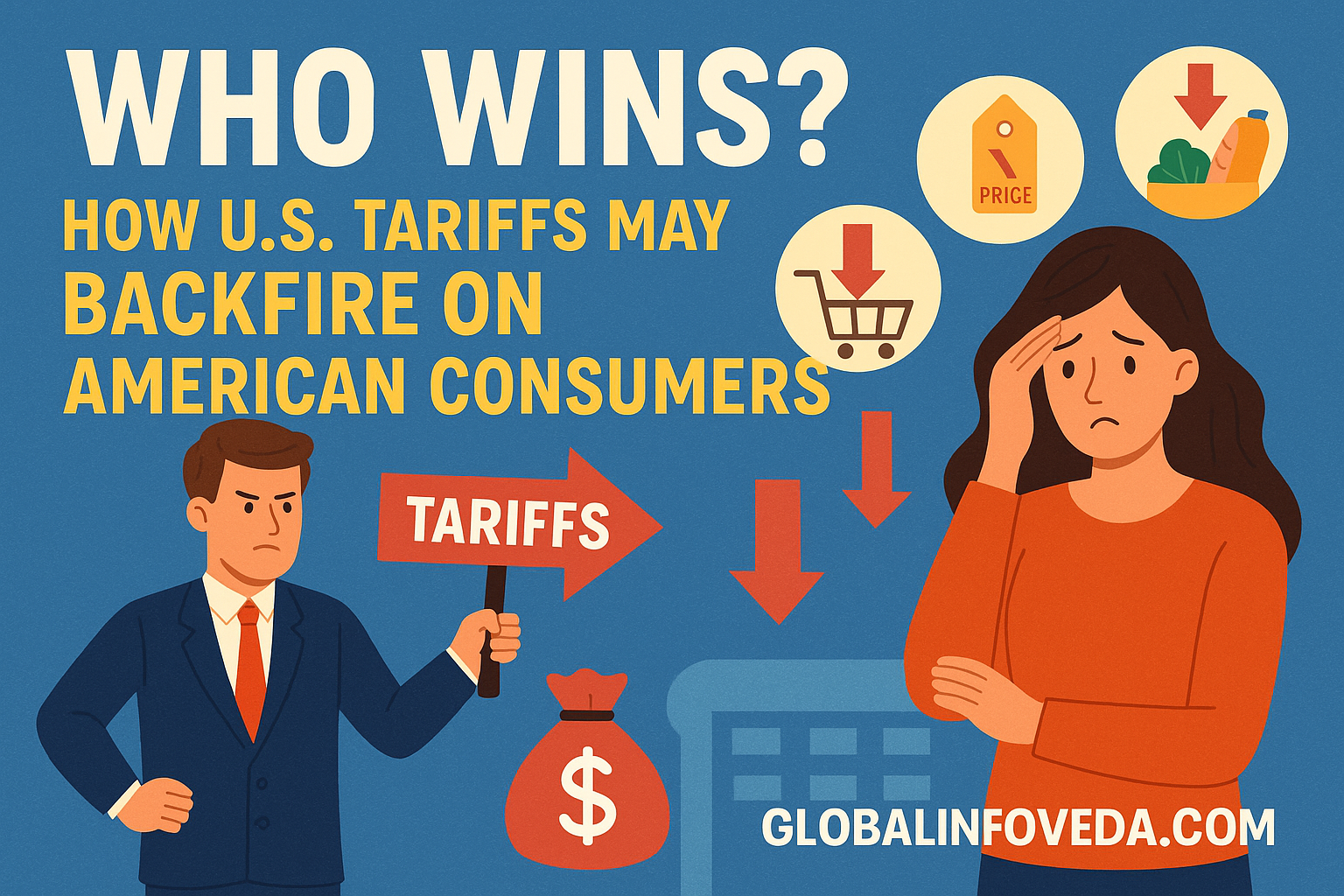How U.S. Tariffs May Backfire on American Consumers
🌍 Introduction: The Illusion of Protection
In 2025, the U.S. government has imposed sweeping tariffs across major import sectors—covering Chinese electronics, Indian pharmaceuticals, Vietnamese textiles, and more. Framed as a patriotic measure to restore American manufacturing, reduce dependence on foreign labor, and correct trade imbalances, this policy is politically popular but economically fraught.
The foundational belief is that tariffs protect domestic industries by discouraging reliance on foreign competitors. But in today’s globalized economy, supply chains are deeply interlinked. American factories depend on raw materials and components from abroad; consumers rely on affordable imports. Rather than shielding workers and industries, the tariff approach risks transferring the cost burden to households, small businesses, and the broader financial ecosystem.
This article dissects how tariffs are effectively a boomerang policy—inflicting more economic pain on the domestic front than they prevent from foreign sources.
📈 Rising Prices: The Hidden Tax on Households
Tariffs are not paid by foreign governments—they are paid by importers, who pass the costs onto consumers. The resulting inflation is pervasive and persistent:
📊 Impact by Sector:
- Consumer electronics: Smartphones, televisions, and laptops from Asia now carry 8–15% markups, with Apple and Samsung passing costs to end-users.
- Medicines: Generic drugs manufactured in India, including life-saving antibiotics and diabetes treatments, are now 12–20% costlier due to FDA inspection bottlenecks and tariff classifications.
- Clothing and basic goods: Common apparel items and footwear from Vietnam and Bangladesh rose 10–18% in retail price.
- Appliances & DIY tools: Products like dishwashers, electric saws, and HVAC components show price hikes of 15–25%.
🔍 According to the Brookings Institution, the cumulative cost passed to U.S. households is an estimated $68–$72 billion in just one year—translating to an average $1,500/year in additional consumer costs.
📉 This “tariff tax” is regressive, affecting lower-income families who spend a larger portion of their income on goods.
🏪 SME Crisis: Squeezed by Input Shock
While large corporations can offshore operations or diversify procurement, small and mid-sized businesses (SMEs) are boxed in:
- 🔧 Raw material shortages: Domestic manufacturers using Indian aluminum or Chinese microchips are stuck with soaring input costs.
- ⏱️ Supply timeline disruptions: SMEs with just-in-time inventory strategies face delays that ripple through sales and deliveries.
- 🧾 Compliance burden: Many smaller firms are overwhelmed by complex customs declarations, duties, and reclassification efforts.
🧠 Example: A family-owned kitchenware brand based in Ohio reported a 22% increase in overall costs after switching to alternate European suppliers—not because European goods were cheaper, but because Asian suppliers became cost-prohibitive.
💡 According to the National Federation of Independent Business, over 38% of SMEs report delaying expansion or hiring due to tariff-related unpredictability.
⚙️ Broken Supply Chains: From Port to Aisle
Tariffs strain not just budgets—but the entire logistics architecture:
- 🚢 Shipping detours: Vessels reroute to Canada, Mexico, and other tariff-light nations, increasing lead times.
- 🧱 Port slowdowns: Heightened inspections create choke points in Los Angeles, New Jersey, and Seattle.
- 🛒 Empty shelves: Major retailers report inventory shrinkage of 12–20% for seasonal goods like winter apparel and electronics.
- 📦 Fulfillment backlogs: E-commerce platforms experience longer delivery lags, undermining Amazon-style just-in-time models.
📉 In a 2025 study, LogiTrack Global pegged logistics-related losses at $40.3 billion, with ripple effects on retail, trucking, warehousing, and packaging sectors.
🏦 Macroeconomic Effects: Inflation + Interest Pain
Tariffs are accelerating inflation—especially for core goods—and complicating monetary policy:
- 💸 Core CPI has risen 1.1% due solely to tariff-related pressures, say analysts at Capital Economics.
- 🏦 In response, the Federal Reserve holds interest rates at 5.75%, delaying expected cuts.
- 🧾 Consumer loans, home mortgages, and credit card rates remain high, stifling purchasing.
- 🧠 Consumer confidence index dropped to 78.3 in Q2 2025, the lowest since late 2022.
⚠️ These compounding effects can create a stagflationary environment, where economic growth slows while prices remain high—hurting both consumers and businesses.
🏁 Winners and Losers: The Trade-Off Landscape
✅ Winners:
- Some U.S. manufacturers (especially those in niche, high-margin sectors like defense or construction)
- Lobby groups and domestic unions pushing protectionist narratives
- Countries like Mexico and Brazil, which are absorbing trade diversion from China and India
❌ Losers:
- Low-income U.S. households, who now face higher prices on everyday items
- Retailers and SMEs, unable to pivot supply chains efficiently
- Tech and pharma sectors, which face dual pressure from tariffs and regulatory barriers
- U.S. geopolitical influence, as trade partners reduce reliance on American consumers
📝 Case Study: An Arkansas-based logistics company reported a 30% drop in import handling volume in H1 2025, losing business to Canadian ports. That loss cascaded to warehouse jobs, fuel sales, and regional tax revenue.
🧭 Final Insight: Economic Populism, Fiscal Pitfall
The instinct to protect national industries is understandable—but blanket tariffs are a blunt instrument. They don’t distinguish strategic sectors from consumer essentials, and they don’t account for modern supply chain complexity.
Rather than tariffs, experts advocate:
- 🎯 Targeted incentives for reshoring high-tech production
- 🔁 Diversified bilateral trade deals (beyond adversarial power plays)
- 🧠 Investment in supply chain digitization and resilience
In a world where economic sovereignty matters, tariffs may buy short-term applause but cost long-term prosperity.
📡 For more insights on trade policy, inflation, and global consumer trends, visit GlobalInfoVeda.com
